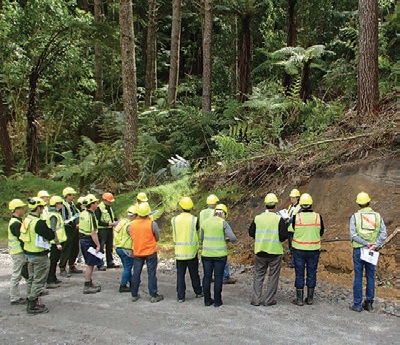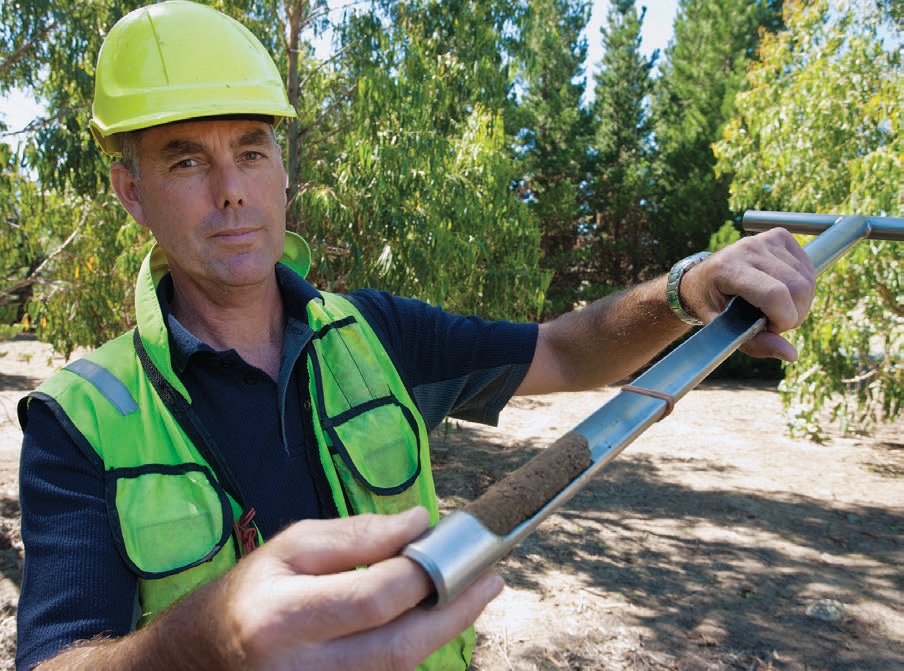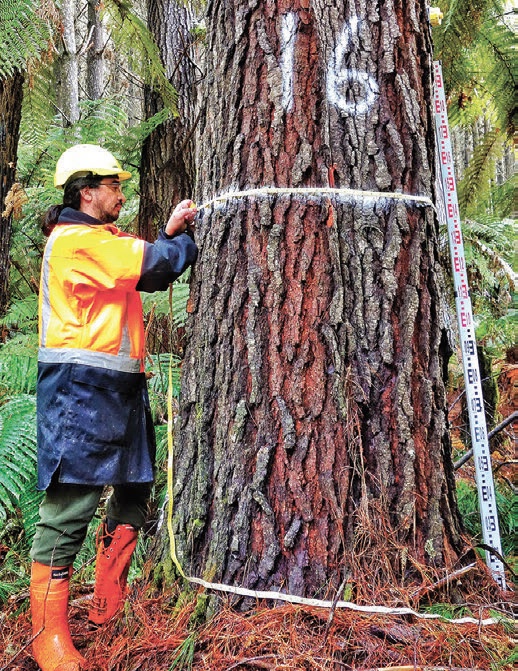
This is free.
Soils underpin the future of our forests
Simeon Smaill and Michelle Harnett, New Zealand Tree Grower August 2017.
Soil forms the foundation which supports the forestry industry. Managing the mix of minerals, microbes, moisture and organic matter which make up soil to get the greatest tree growth while maintaining soil health is critical for sustainable long-term forestry in New Zealand. Work being carried out at Scion under the Growing Confidence in Forestry’s Future programme aims to equip all forest owners and managers with the knowledge and methods to meet this challenge.
Tree health starts in the nursery with vigorous seedlings that grow into robust trees. The microbial make-up of nursery soil plays an important part in this process. Some soil fungi form symbiotic relationships with plants. These mycorrhizae − literally root fungus − colonise a host plant’s roots. The fungal mycelia act as a very fine and long extension of the plant’s roots, absorbing water and minerals which are shared with the plant. In return, carbohydrates made by the plant are transported to its roots where they can be used by the fungus. The more the mycorrhiza helps the plant, the more carbohydrate the plant can provide to the fungus – it is a mutually beneficial relationship.

Radiata has a lot of fungal friends
At least 28 different mycorrhiza species are known to be associated with radiata pine. Some species form better partnerships with radiata pine than others, providing greater benefits to the plant. Seedlings colonised with more of these better species of mycorrhizae thrive and grow more quickly for several years after planting when compared to seedlings colonised by other mycorrhizae.
Promoting and encouraging healthy populations of mycorrhizae in nursery soils has the potential to further improve the performance of seedlings. Soil and plant ecologist Simeon Smaill, and other Scion researchers, have been looking at the effects of routine fungicide spraying and fertiliser application. They have found that seedlings which are given lower levels of fungicide had greater survival rates and grew faster than seedlings which received a standard dose.
The work on reducing the use of fungicides has moved from small scale trials at Te Ngae Nursery and Scion’s research nursery, to operational scale trials at the ArborGen nursery in Tokoroa. A 50 per cent reduction in fungicide has helped rather than harm the seedlings. Reducing the amount of nitrogenous fertiliser has also led to growth gains. Seedlings from this study have been planted out at sites around New Zealand with forest growth results expected between 2018 and 2020.
The work to date has shown that it is possible to make savings with reduced chemical costs without compromising seedling growth and survival. As the results from the field trials become available, and with further research focussing on getting even greater benefits from the tree and mycorrhiza relationship expanding to a greater number of nurseries around New Zealand, forest owners can be confident they are planting healthy seedlings with strong mycorrhizal partners.

Nutrients by the numbers
Forests tend to be on less productive soils with lower nutrient levels. Some soils around the country are known to be deficient in nitrogen, phosphorus, magnesium and boron. The flow and availability of nutrients within pine forests has been widely studied over the last 40 years. While applying fertilisers can improve tree growth and productivity, concerns and questions about the use and cost-effectiveness of fertilisers still remain.
In the case of nitrogen, a faster growth rate could affect wood quality, especially wood density. It can also be difficult to predict the effects of applying fertiliser. Forests are complex systems and factors such as forest age, availability of other nutrients and water, and the presence of pests and weeds all complicate and obscure the effects of fertilising the land. These, and rising costs, have contributed to a decline in the use of nitrogenous fertiliser over the last two decades.
Phosphorus is another nutrient that, if applied more widely and not just where it is known to be deficient, should increase tree productivity. However, as with nitrogen, the unpredictability of the growth response is resulting in a decline in use.

Precision management
Precision nutrition management which removes this uncertainty – knowing what, where, how much, and the best time to apply fertilisers for the greatest productivity gains – has been identified as the best way forward for fertiliser use. A main sticking point to developing this method is the lack of nutrient availability data at specific sites. To remedy this, forest soils around the country need to be sampled and analysed. Encouraging individual owners and managers to do their own sampling is a practical and cost-effective way to collect soil samples, and numerous forest owners are now carrying out this work.
A survey of farm foresters, small-block owners, corporate foresters, and other industry stakeholders in 2015 found that the role of soils in productivity was well recognised. Owners and managers were interested in using soil data, but were unsure how to take soil samples, or how to translate soil data into forest management. The issue of the nitty gritty of soil sampling was addressed by a series of ‘how to’ workshops and videos supported with written instructions. Small to medium forest owner who are interested in getting their own soils tested can check out the instructions and get the analyses done at a commercial laboratory such as Veritec or Hill Laboratories then discuss how to use the results to increase productivity with Scion staff or forest management consultants.
From information to action
To be useful, data from the soil samples needs to be translated into practical forest management recommendations. For the last 25 years, scientists at Scion have been developing and improving a nutrient balance model with the odd acronym NuBalM. This model predicts how nutrients affect growth at stand level, the effect that management decisions could have and how to ensure soil quality is maintained to support future rotations.
NuBalM considers how nutrients are cycled during a stand’s lifetime. The model uses indices of site productivity to make initial growth predictions under different silviculture regimes. Then the nutrient demand needed to support the predicted growth in a given year is calculated and the nutrient supply available is estimated. Comparing demand versus supply, NuBalM then revises the productivity predictions. Nitrogen is the main nutrient considered currently, but the model also tracks phosphorus, calcium, potassium and magnesium flows.
A lot of variables
The minimum number of site parameters needed to run the model is six − 300 Index and Site Index, stocking rate, rainfall, organic matter in the soil, and an estimate of soil fertility. Up to 200 more variables can be used if they are known.
NuBalM’s accuracy has been checked by comparing its predictions with actual observations taken in 32 locations across the country. Simulations were run using the minimum six inputs. It was found that there was close agreement between predicted and observed values for stem wood mass across a range of stocking and thinning regimes, and low to medium fertiliser regimes.
More data was available for two long term productivity sites in Tarawera and Kinleith, especially about the amount of organic matter in the forest soils, and the effect of fertiliser on available nitrogen. This extra data was used to check how accurately NuBalM could predict above ground biomass and the distribution of nitrogen in the soil.
A more detailed simulation with 18 variables accurately predicted biomass except where extremely high levels of nitrogen had been applied. In that case the model under-estimated the amount of stem wood mass. The model also accurately predicted total nitrogen levels, but not its distribution in different soil layers.
Work is continuing to refine the model and increase its accuracy and ease of use. For example, the model considers the effects of nutrients on weed growth but only allocates nutrients to weeds after the needs of the pines have been met. This is too simplistic as weeds and trees will be competing for the same nutrients. Nutrient leaching and the effects of other minerals are also focus areas. Leaching information will be particularly useful in the development of catchment level nutrient management plans, which are becoming an important consideration for land managers and regional councils.
Sustaining successive rotations
The short forestry rotations in New Zealand of 25 to 30 years result in frequent and significant forest soil disturbance. More than 50 per cent of the country’s planted forests will soon be in their third or fourth rotations. The pressures of short and successive rotations can lead to soil degradation and a drop in its ability to support the subsequent rotations. Loretta Garret and other Scion researchers are evaluating the effects of successive rotations and how they affect site productivity.
Organic matter in particular is critical to nutrient supply in forests. The amount removed at harvesting influences the nutrients available for the next rotation. Scion has used observation and theoretical methods to investigate the effects of removing organic matter. The first method used the Woodhill Long-term Site Productivity Trial to assess soil changes over two rotations. The second used NuBalM to simulate the response of nitrogen and radiata pine productivity to the removal of different amounts of organic matter at harvest.
Removing parts or all of the trees
The sandy soil of the Woodhill site is low in carbon and nitrogen. At the end of the first rotation in 1985, parts of the site were prepared for replanting by removing either just the stem, the whole tree or the whole tree plus the forest floor. Half the site also received large doses of fertiliser, with the aim of removing all possible nutrient limitations the trees might face. As a result, the amount of fertiliser used was much greater than would ever be conventionally applied. The second rotation at Woodhill was harvested in 2014.
Leaving harvest residues in place benefitted soil carbon and nitrogen levels, whereas removing most of the organic matter in the form of the whole tree and forest floor decreased the carbon and nitrogen levels in the top 10 cm of soil. Adding fertiliser to the scraped ground did increase overall carbon and nitrogen levels but did not restore the values of those nutrients to the initial value. Fertiliser application also reduced the amount of phosphorus available.
The theoretical effects of the different site preparation regimes used in the Woodhill trial were also simulated with NuBalM over four rotations, using data combining current growth trajectories from six New Zealand regions. The predicted changes in nitrogen levels and how they could affect stem wood biomass or productivity were calculated.A factor to account for genetic gains with time was included in the modelling.
Decreasing nitrogen
The model results showed the amount of nitrogen in the soil decreased with successive rotations, and that the decrease was larger and faster as increasing amounts of organic matter were removed. The effects on simulated productivity were minimal for the first two rotations. Beyond that, the effect was substantial. By the fourth rotation, a 75 per cent loss in productivity was calculated for the whole tree and forest floor regime and a 25 per cent loss calculated for the whole tree treatment. No loss of productivity was predicted within the four-rotation simulation for the stem only removal.
The results from theWoodhill trial and NuBalM modelling show that management decisions around organic matter removal affect nutrient levels and therefore productivity. The simulation suggested there is a threshold where productivity will be markedly affected.With more site-specific nutrient data and information on the factors that affect this, avoiding soil degradation and maintaining productivity, especially on low nutrient sites, will be easier.
Closing the productivity gap
The site productivity of nitrogen deficient Woodhill is much lower than the most productive sites in New Zealand. Understanding and correcting site nutrition to close the productivity gap is one of the aims of Growing Confidence in Forestry’s Future. The productivity gap defines the difference between the biological maximum productivity for the site and the current productivity achieved from that site – basically, the gain in productivity that can be produced by the land owner from research which improves management. Given the large number of factors that could be restricting productivity, solutions are likely to be complex and involve multiple treatments. Using Woodhill again as an example, adding nitrogen fertiliser would increase productivity, but not to a theoretical maximum as the availability of phosphorus or another nutrient will eventually limit growth.
However, the task is not impossible. Understanding the factors that influence nutrient use, availability and growth, along with their interactions, is increasing all the time. Data from fertiliser trials is showing that the response to fertiliser takes time, and that three to five years after application, soil phosphorus content and moisture availability accounted for around 80 per cent of the differences in fertiliser growth response. These and similar results will allow forest owners and managers to predict the returns on nitrogen fertiliser more accurately. There will be opportunities to increase growth responses further by improving the phosphorus content of a site’s soil, for example, and supplementing other growth limiting nutrients.
Combining our knowledge of where site productivity is below its biological potential, increased soil sampling and analysis, methods such as NuBalM will enable precision nutrient management to become a routine part of forest management. Healthy, productive and sustainable future forests will give the best return to owners and growers with the added benefits of protecting our soil capital, improving our environment with better ecosystem services and providing renewable raw materials for new bio-based industries.
For more information on soil research at Scion email simeon.small@scionresearch.com

 Farm Forestry New Zealand
Farm Forestry New Zealand